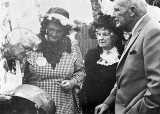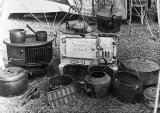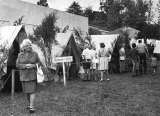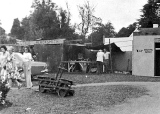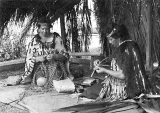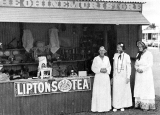Ohinemuri Regional History Journal 19, June 1975
In preparation for the Centennial celebrations the Thursday Committee, chaired by Mr. Cowern, held weekly meetings of interested group delegates. Ena Buchanan and Mona Beattie represented the Paeroa Historical Society which undertook the setting-up of a "Pioneer Village" as its chief contribution. Its various sub-committees soon had plans under way and I have asked them to report for our Journal their activities during this big community effort. (Ed.)
[this report is one of several covering the 1975 Centenary Celebrations of the Opening of the Goldfields; see 1975 Centennial Programme for the programme of events, and links to other reports - E]
[see below: At Home in a Tent, The Ohinemuri Store, The Blacksmith Shop, The Talisman Assay Office]
"AT HOME IN A TENT"
By Mona Beattie
Dorothy Waldegrave
Greta Locke
The project of establishing a Pioneer Village was an exciting one and many suggestions were made concerning different aspects. Our sub-committee finally decided to be "At Home In A Tent" (or Tents!) such as those which were lived in 100 years ago when families were brought up the river to settle in Paeroa.
Where were those tents to be obtained? Maurine Reid soon found that answer. The old ridge-pole tents that had previously belonged to the Netherton Scouts but were now held by the Paeroa Scout Committee - and permission was given to use these. Where should we settle? The Methodist Church Grounds? Permission granted by the Methodist Quarterly Board to use the area surrounding the Church, this proved an ideal place, beside an historic Church, built in 1882, which was soon the centre of attraction for the town's celebrations. It was used by many visitors as a place of quiet meditation or to reflect on past years spent in its congregation or again to eagerly scan old photos displayed in the vestibule. The Rev. John Watson who spent many hours with us helped to complete the picture of years gone by.
We had the tents - now, from where - the furniture?
"Mona Beattie had a special gift for enquiries, as I found on one exciting morning following a phone call", said Dorothy Waldegrave. " 'They are pulling down an old house on Puke Road, just over the railway line; will you come with me to see if we can get a mantel-piece for Mick Bullock's colonial fireplace?'" In a jiffy we were on the site, the wreckers making timbers fly. It was the work of a moment for Mona to raise her voice above the din, "Who is the boss around here?"
"I am," said Mr. Cullerne, as he came down to hear her story.
"We are from the Historical Society"(which gave us status at once) "and are greatly in need of the loan of a fireplace surround". Not only was the very thing forthcoming, but also an old-fashioned kitchen dresser, the finding of which we had actually given up in despair. Yes, he would lend us both - only too pleased and deliver them too. Yes, we could paint the surround if we wished. Mona duly did, in a delightful antique brown, into which Mick's fabricated colonial fireplace - hobs, bars and all - and black as soot, (for he had used paint, giving a great effect,) fitted just as if made to order. Russell Locke had collected these items for us and Dorothy polished the dresser for our parlour, which was decked out with precious pieces of ancient dinner sets, and with the fireplace in the kitchen tent was a grand foundation for tents 1 and 2.
Of the five days we were on the grounds perhaps the busiest was prior to the "Opening". Our men-folk, including our President Fielden Thorp, collected antique furniture which we had located and lifted these heavy items into place. (How was furniture handled so long ago? - Perhaps many times by womenfolk).
Dorothy Waldegrave arranged a roster of not less than 8 persons at a time to be on duty for several (+) hours daily. They were:- Nellie Bain, Mavis Bradburn, Mona Beattie, Ena Buchanan, Nell Climie, Thelma Crimmins, Sybil Dance, Mary Fennell, Gladys Farrell, Phil Hughes, Greta Locke, Ethel Mora, Grace Morran, Eileen Mathieson, Flo Morgan, Lea Majurey, Mary Peckham, Mary Simpson, Sadie Strange, Ivy Thorp, Dorothy Waldegrave, Letty Wildemoth, Joan Wilson, and Elsie Way. They were all dressed in period costume, (many frocks, and hats being supplied by Maurine Reid & Mary Simpson), and during every moment of duty were explaining to interested crowds, including School Parties.
The nursery tent with four delightful infant's dressed in 100-year old christening gowns, the iron railing cot, the very old child's chair and rocking chair plus patchwork quilts and cushions, clothes and pictures of years ago completed tent Number 3.
The bedroom tent held the iron bedstead, a marble-topped wash-stand complete with very lovely green crockery set, chest-of-drawers, and a real live woman by the bed, gowned in a hand-tucked garment of finest lawn, trimmed with hand-made lace. Incidentally when word went round that the Governor General, Sir Dennis Blundell and Lady Blundell had arrived at our village, this interesting invalid (none other than our Mona) had only time to re-arrange herself in the rocking chair beside the bed, with a patchwork quilt over her knees before the Vice Regal entourage arrived at the door to ply her with questions regarding the many interesting exhibits this bedroom held. Our President's wife, Ivy Thorp, was attending the nursery tent during this visit and the Vice-regal pair both took great interest in the baby gowns and asked for a close look at a robe that was hand-tucked, with lace hand-sewn, which had been exquisitely laundered by Clare Fennell. The old razor strop and cut-throat razor created great interest. Many were heard to say they could still 'feel' the razor strop around their seat! It is now a museum piece and unknown to children of today. The old organ, loaned and played by Grace Havill at the request of Sir Dennis, was much enjoyed.
At the kitchen tent many old gadgets were displayed, among them: butter churns and wooden pats, iron pots, pans, camp ovens, a brown dalton jelly mould, and irons - flat, charcoal and Mrs. Potts, to name a few.
The highlight, of course, was the washing display suggested and erected entirely by Reg. and Irene Hughes. This was a real old-time washing outfit which included a kerosene tin on the fire and a mangle on a cut-down barrel. The line, erected on teatree poles, had a prop, and on this flopped the underwear as worn by Grandpa and Grandma ("bless their hearts") - gorgeous camisoles, daring stays, and oh! the drawers!! On view too were the tin trunks that had contained these historic clothes.
The co-operation between Societies was wonderful. When we made a call for "night security" on the village, R.S.A. representatives came forth willingly for Thursday night from 8 p.m. - 8 a.m. and Mr. R. Cowern arranged for Friday night. This part was a real get-together of Paeroa people. Lighting was also arranged for night security and N.D.A. offered to store articles overnight. From 7 a.m. each morning members arrived to open up the tents and to put the valuable "bits and pieces" into place.
Our members, who sold centennial souvenirs from the first tent, did a grand job, especially the first day, when down came the rain and the water poured off the street and through the tents; they were soon standing in water as must have been the pioneers 100 years ago. Our workers enjoyed their jobs and "the fruits of their labour".
We spent Saturday clearing up in heavy rainy returning wax models to Tom Carden and Mrs. Spinks as well as items so kindly lent by Paeroa folk. Our appreciation also to Gladys Farrell and Mavis Bradburn who, working quietly at the back of the Church, supplied tea at any time when our need was great. Nearly all local members of the His. Soc. were involved in some way during our Pioneer Village Project.
After attending the combined Church Service in the Paeroa Domain (which turned out to be a sunny Sunday morning), one could walk through the Church grounds and apart from the Model Maori frame, saw no sign of a bustling village where so many had trod, looked and talked about living in a tent 100 years ago.
THE OHINEMURI STORE
By IRENE HUGHES
It was decided the two Reid families and the Hughes' were to be responsible for "The Ohinemuri Store", part of the Pioneer Village, being constructed by the members of the Historical Society, on the lawns surrounding the Paeroa Methodist Church.
All manner of ideas flashed through our minds. Finally Arthur and Jim Reid designed and built a suitable structure of corrugated iron and timber resembling as nearly as possible, a shop of a century ago. Dennis Lee and Reg Hughes gave a helping hand. It was made and painted on the Reid farm; quickly assembled on the village site with name plate attached. The front was also adorned with a large enamel Lipton Tea sign, a relic of the grocery store belonging to the Robson family who built it in Paeroa in 1876 and we had a brass grain scoop from the same source. - Now we were ready for business.
Then came ideas for stocking the store, this matter being largely left in the hands of Noeline and Maurine Reid and Irene Hughes, with other members being asked to lend what articles they could - also to help supply produce. We needed bags for flour, sugar, salt and oatmeal, also for chaff, oats and wheat; tins for tea, matches and tobacco - Jim Reid had a large collection - manybrands were unavailable. We had candles and candle-sticks, kerosene lamps lanterns, and kerosene for pre-electricity days; lemonade bottles with a marble stopper and a wooden opener needed to push in the marble. There was a blue castor oil bottle, valued now at $60, and collected each evening by its owner as being too precious to leave over-night. Remember that castor oil? Ugh!
There were earthenware crocks; old preserving jars with glass and galvanised lids; bolts of calico, flannel, gingham and sateen, to supply materials for garments for wives and children; saddle tweeds and braces, cut-throat razors and collarless shirts together with the stiff separate collars (for use on special occasions) for the men - damask and embroidered cloths for the table with old silver cutlery, and china dinnerware, also the humble but useful tin and enamel plates, billies and mugs. Toasting forks and ancient bread knives hung from a row of hooks. A large wooden potato masher attracted attention -- the children couldn't guess what that was. There was a tomahawk to cut the kindling, tools for the garden and farm, a bullet moulder for more sinister purposes, and Maori kits.
The shop assistants, suitably attired in period costumes covered by voluminous bib-front aprons, presided at our sales counter - pride of place being taken by a bacon-cutter. This had been found in an old disused shed, and had been meticulously dismantled, cleaned, oiled, sharpened, painted and reassembled in working order by Reg Hughes. It was complete with a rather doubtful roll of bacon. Also in excellent working order was the Reid family's remarkable apple peeler, corer and slicer - one wondered why such a thing was not now in every day use. Dennis Lee prepared an account form with goods priced as they were 100 years ago.
Trade was buoyant - just as well we had Kay Morrison as an extra shop assistant. Fruit and vegetables rapidly changed hands for shillings and pence. Delicious home-made sweets sold for 4 ozs. a 1/-, much dearer than in 1875, of course. Jars and boxes of shortbread, queen cakes, chelsea buns, rock cakes, scones, pikelets, and ginger gems, yes and cream cakes too, disappeared from our counter as our cash box became fuller. Mrs. Sam's delicious home-made bread - some cooked in a camp oven - was really rushed. Sparkling jellies, jams, and pickles were soon snapped up by eager customers. Lavender and pot-pourri bags were for sale too, as were genuine home-made bars of laundry soap and crocheted milk jug covers. Tom Morris brought us his own hand-turned wooden articles made from a kauri post from the Talisman mine in Karangahake.
The store was open from the Thursday to the Saturday, the highlight of the period being a visit from the Governor General and his Lady, on the Saturday morning. Much to my surprise, I found myself addressed by Mr. Neil Clarke with "What have you for sale?" and there right before me was the Governor General. Quickly I replied "a packet of Park Drive at 1/3, your Excellency, and would you like a penny box of matches to go with it?" Then the Governor General and Lady Blundell each sampled a slice of apple placed before them by Maurine Reid who was busily demonstrating the slicer - we ate the rest of the apple.
Often in the early days the General Store received and dispatched Mail, so we were grateful to the Post Office for the temporary installation of an authentic Box and, letters posted there were specially franked. Also on display was our Historic Mail Notice Board on which the word STEAMER was prominent.
Nearby was the Wharepuni that has graced the riverbank during the "Signing of the Deed of Cession". It provided an attractive setting for demonstrations of Maori Craft such as the making of flax kits and komo (food baskets) by Mate [Mata ? – E] Royal and Lily Te Moananui.
Special mention must be made of guard duties willingly and cheerfully undertaken one night by George Way and Jim Reid. - One doubts if either slept that night. But trials and tribulations as well as good things must come to an end; thus to the packing up and dismantling. In no time at all contributors collected their belongings, shelves were cleared, and the building once again relegated to a heap of corrugated iron and timber. The story of the life of "The Ohinemuri Store", revived 1975, was complete.
THE BLACKSMITH SHOP
By HAMISH WILSON
Having decided that a Forge and old machinery display should be a feature of our "Pioneer Village" it was left to my wife, Bob Murdock and myself to arrange the collection and assembly of the necessary material. With boyhood interest and experience with ponies and farm horses, I imagined the task would be easy and concentrated on the "live stock" first. But times have changed and horses are now rare. However between Christmas and the Centenary Celebrations I managed to locate some - a good looking Clydesdale gelding that had the nature to tie and handle, and a couple of handy farm draught horses that would enjoy a few apples while tethered near the shop.
During quite a few Sundays we spent time locating different equipment from farms and homes in the district, including the Bruce Alley's at Hikutaia, Alex Rasmussen, Mr & Mrs. Sam Orr, Vedders Road. (The latter supplied my wife with a bonnet and coat over 100 years old and Harry and Jean Spinks provided valuable antiques, while many other folk brought a great variety of treasures to us. We listed all the items from donors and it was then that we felt the risks were great in that if anything happened to these valuables on loan, who would be responsible? We had one purse so old that it was put in such a safe place that it was forgotten and not until the celebrations were over did we realise that it had not been on display).
Tuesday 25th February was get together day and a start was made assembling all our gear. Our layout on the eastern side of the Methodist Church was to be for the old farm machinery and the Shop. Old iron was brought to Russell Lockes where with Mick Bullock a prefab was assembled and then transported by the Slavich Bros. to the building site. At the beginning of Celebrations Week, Fred Bradburn, Reg Hughes, Tom Carney, Arthur and Jim Reid with overseers Murdock and Locke erected a fine one room Shop. Bricks and forge from Trevor Bramble and John Carter made a suitable fireplace, permits and regulations were all in order and inspection passed. Original signwriting was done in bold lettering - ELLIS. Three local ex-Blacksmiths had been interviewed as their service at the forge would be needed if possible to show their hand at the fading art of the old smithy. Cliff Strong, nearly eighty years old and Jack Furey recently retired in Waihi, would be active but because of illness Alex Armour felt he could not be striking the anvil.
Under the watchful eye of Russell Locke three good old-fashioned totara posts were hewn into shape for a truly "olden days" tethering rail and fence. This exhibit was noticed by many older folk and shown to the younger ones who asked why it was done that way. The manuka rails used in all the buildings and fences came from Omahu and were delivered by Russell Green and Doug Mold of the Kerepehi Pony Club.
Wednesday 26th our village was taking shape, implements arriving, excitement building;
Thursday was an earlier than usual start, two horses were to walk in from Netherton and I was to meet them on the way. It took nearly two hours plodding before we were on the site and the horses tied behind the tethering rail specially made for the public to see. John Paul delivered the Clydesdale to the site and implements delivered from Alex Rasmussen's and an old dray from Thorp's. We were ready for business!
Friday morning at 6 a.m. - 7 a.m. the horses were again lead onto the site from grazing and more valuable exhibits which had been stored overnight were laid out again. Crowds and visitors were soon arriving after 10 a.m., School groups and older identities taking time to ask questions and reminisce of olden days. The smell of furnace smoke wafted around as we stoked up the forge, the ring of the anvil brought back the stories told by Cliff Strong and Jack Furey. They showed their skills on shaping pieces of iron and spent time showing the methods of shoeing the big Clydesdale which was very placid during the demonstration.
Again on Saturday morning the smoke curled from the smithy and the crowds were just as great with a special visit from the Governor General and his Lady and their party. They stressed the need for a museum for the treasures we had collected and the Borough members agreed with the Historical Society that Paeroa needed such a building programme.
By midday, packing and clearing away all the exhibits was starting as our Centennial was now behind us. The task of returning all lent articles was a rush. Sorting out took time and though a number of things briefly disappeared they were found later, in drawers or boxes for safe keeping. The Methodist Church grounds on Tuesday 4th March were back to normal, our used up energy had been regained - there was a feeling something was missing; maybe we were missing the excitement of the previous week. The memories and photos of the Pioneer Village -- a small part of our first 100 years.
THE TALISMAN ASSAY OFFICE
By BEN GWILLIAM
Our Historical Society Meeting came alive once we had decided on the Pioneer Village theme. Then out of the blue our Chairman said, "We all know that it was the discovery of Gold at Karangahake that brought closer settlement to this district. Now Ben, you're a mining man, what are you going to do about it'?" Rather taken by surprise I said I couldn't dig a mine in our Village, but I'd give the matter some thought. So the next day I co-opted my work-mate Bert Dagger and in our imagination we built crushers, Wilfley Tables, Berdans, and Stampers. In fact it was obvious we would have needed the whole Village Site for our project so after a day or two we scrubbed it.
At this stage Bert suggested that we could build a pre-fab Assay Office. "That's it", I agreed - "The Talisman Goldmining Company Assay Office" All we needed was my iron, Bert's timber and .a few sheets of wall board from the Southern Cross Mining Coy, - it was at their workshop in Francis Street that our Assay Office was built. I recall that at 11 o'clock one night Nick Frost from the Ministry of Transport came and painted our Talisman sign -- an excellent job in old time sign-writing (Thanks a million Nick!)
Bert went off up the 'Hake Mountain to No.5 Talisman mine with the little Morris 8 Van, and brought back a load of gold bearing quartz. To add a little colour to our samples I travelled to Waihi and located the Managing Director of Waihi Mineral Resources (Mr. Jack Barbarich) to explain our project and he promptly phoned his mine at Te Aroha and had sackful of Lead, Copper and Zinc Ore sent down to us. (Thanks Jack!)
Then another problem loomed. We could not cart the Office in the Company's little Morris Van. I was out on the road, evidently with a very worried look, when our milkman Brian Dunham drove past and stopped. "Why the troubled face, Ben?" he quipped. When I explained, his reply was instant. "Name the time and place of delivery", he said, "and the job is done".
The shift was made at 8.30 a.m. on the Opening Day and Bert and I proudly installed our Office and Plant including Crusher, Berdan and furnace all complete. But it would have been dead without Power to drive the Machinery. However Bert knew the Butcher next door (Trevor Mora) and to him we explained our worry. "If you chaps are going to all that trouble", he said "then I will supply the power free of charge".
(Note how we had many to thank, both before and then after the Celebrations when equipment was returned).
The process of assaying the crushed quartz in order to assess the mineral value of specimens has been explained in other Journals so I will not repeat them. By the excellent comments of many hundreds of visitors who passed through our Pioneer Village it was an impressive success and this was very gratifying to all the participants.
P.S. – As a point of interest perhaps to some readers, Bert and I are erecting our small extraction plant up at No.8 Level at Karangahake and hope to be extracting gold and silver about October.
J. Reid – Photos

